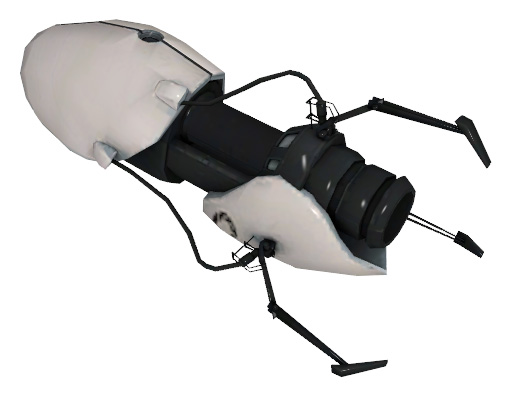Now you're think-0
VIDEO GAME-DERIVED CHARACTER ADAPTATIONS
APERTURE SCIENCE HANDHELD PORTAL DEVICE
Target: 2m Radius
Duration: Constant
Range: 100m
END Cost: 0

Description: The Aperture Science Handheld Portal Device, or ASHPD, is a highly advanced experimental energy projection tool used to create linked teleportation gates (or portals.) The object is mostly white, with a black camera-like barrel at one end, surrounded by three branching “antenna.” The ASHPD has two triggers. The primary trigger fires blue portals, while the secondary fires orange ones.
Objects (or people) who enter the blue portal will exit the orange one, and vice versa. In addition, the portals create a direct link, that preserves velocity and facing. Objects entering a portal at a high rate of speed with exit the opposite portal at the same rate. Or, as GLaDOS puts it: "Momentum, a function of mass and velocity, is conserved between portals. In layman's terms, speedy thing goes in, speedy thing comes out." This feature allows portals to be used to fling a target object or character long distances, simply by creating a portal high up on a wall and another at the bottom of a long drop. Fall into the portal at the bottom of the drop, and be ejected from the linked portal at the rate you were falling. This can allow the user to travel upwards of 300 feet if done correctly.
Portals can be created on most surfaces, including concrete, wood, ceramic tiles, and so on. Portals can’t be created on glass, metal, doors, water, and certain forms of Enrichment Center Testing chamber tiles (specifically the dark bronze ones, the white ones are fine.) However, the specific surfaces portals can and cannot be created on are up to you, the GM. Note: per Portal 2, portals can only be created on surfaces covered in white gel, which is made from ground up moon rocks.
In order to create a complete portal, you need to first fire off either an orange or blue portal. Once you’ve created the initial anchor, you must then select a spot for the final anchor. Each of these portals requires its own Attack Roll. You can, if you wish, use Multiple Attack to create both portals (and thus, a complete gate) in a single Phase. In addition, portals can be created under objects and people, allowing you to drop them elsewhere. A created portal is roughly 2 meters across, and wide enough to accept an Aperture Science Weighted Storage Cube (also known as an Aperture Science Weighted Companion Cube.)
The energy beam that creates portals will simply bounce off and dissipate harmlessly if fired at surface unable to accept a portal anchor. The beam can also be fired through chain-link fence and certain close-mesh grind fencing, but will not go through energy fields. The maximum range of the ASHPD is unknown. In Portal it seemed to be around 100 meters, while in Portal 2, the range initially seemed to be between 250 to 500 meters. However, at during the climatic battle Chell places a portal on the Moon, which is roughly 382,000 kilometers away (and then travels through it.)
Finally, the ASHPD’s zero-point energy manipulation field allows the user to pick up objects ranging from the size of a coffee cup to a Aperture Science Weighted Storage Cube (which is roughly 1m square.) While the the zero-point energy field doesn’t allow the user to manipulate objects (beyond picking them up), the user can drop them into open portals and even “throw” an object by turning to one side quickly and then turning off the zero-point energy field. New portals cannot be created while using the ASHPD to manipulate an object, however, current portals will remain in existence.
Care must be taken when using the device, however. At no time must the user touch the operational end of the ASHPD, look directly into the barrel , or submerge the ASHPD in liquids of any form. In addition, the ASHPD is so advanced and revolutionary in design, it is worth more than the combined net worth of everyone in your hometown (and that includes you.)
Game Information: Teleportation 250m, Area Of Effect (2m Radius; +¼), Persistent (+¼), Indirect (Source Point is the same for every use, path is from Source Point to target; portals can be created on the other side of certain barriers and fences; +¼), Constant (+½), Ranged (+½), Reduced Endurance (0 END; +½), Usable As Attack (+1 ¼), MegaRange (1m = 10,000 km; can produce a portal on the Moon; +2), MegaScale (1m = 10,000 km; characters can teleport from the Earth to the Moon; +2) (2125 Active Points); OAF (handheld portal device; -1), Requires A Separate Attack Roll For Each Portal (see text; -1), Can Only Create Portals On Certain Surfaces (see text; -½), Required Hands (two hands to carry and use; -½), Gate (-½), STR Minimum 5 (-¼), No Noncombat Movement (teleportation distance is fixed via gate locations; -¼) (Real Cost: 425) plus Telekinesis (10 STR), Reduced Endurance (0 END; +½) (22 Active Points); OAF (handheld portal device; -1), Can Only Lift Objects (cannot crush, throw, punch, and so on; -1), No Range (-½), Lockout (cannot create new portals while using TK function; -½), Affects Whole Object (-¼). 2125 + 22 = 2147 Active Points; total cost: 430 points.
Aperture Science Handheld Portal Device Hero Designer File
0-ing with portals!
Return to Video Game-Derived Character Adaptations